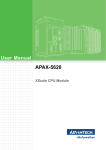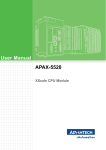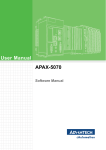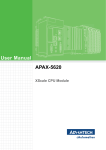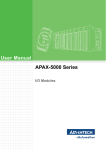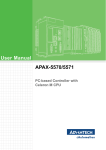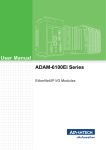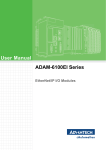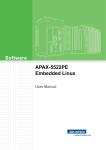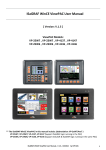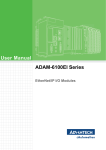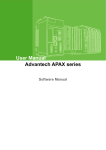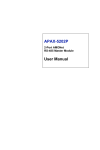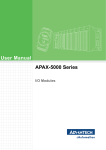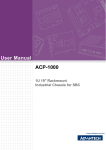Download APAX-5070 Hardware Manual Ed1
Transcript
User Manual APAX-5070 Modbus/TCP Coupler Copyright The documentation and the software included with this product are copyrighted 2009 by Advantech Co., Ltd. All rights are reserved. Advantech Co., Ltd. reserves the right to make improvements in the products described in this manual at any time without notice. No part of this manual may be reproduced, copied, translated or transmitted in any form or by any means without the prior written permission of Advantech Co., Ltd. Information provided in this manual is intended to be accurate and reliable. However, Advantech Co., Ltd. assumes no responsibility for its use, nor for any infringements of the rights of third parties, which may result from its use. Acknowledgements Intel and Pentium are trademarks of Intel Corporation. Microsoft Windows and MS-DOS are registered trademarks of Microsoft Corp. All other product names or trademarks are properties of their respective owners. Product Warranty (2 years) Advantech warrants to you, the original purchaser, that each of its products will be free from defects in materials and workmanship for two years from the date of purchase. This warranty does not apply to any products which have been repaired or altered by persons other than repair personnel authorized by Advantech, or which have been subject to misuse, abuse, accident or improper installation. Advantech assumes no liability under the terms of this warranty as a consequence of such events. Because of Advantech’s high quality-control standards and rigorous testing, most of our customers never need to use our repair service. If an Advantech product is defective, it will be repaired or replaced at no charge during the warranty period. For outof-warranty repairs, you will be billed according to the cost of replacement materials, service time and freight. Please consult your dealer for more details. If you think you have a defective product, follow these steps: 1. Collect all the information about the problem encountered. (For example, CPU speed, Advantech products used, other hardware and software used, etc.) Note anything abnormal and list any onscreen messages you get when the problem occurs. 2. Call your dealer and describe the problem. Please have your manual, product, and any helpful information readily available. 3. If your product is diagnosed as defective, obtain an RMA (return merchandize authorization) number from your dealer. This allows us to process your return more quickly. 4. Carefully pack the defective product, a fully-completed Repair and Replacement Order Card and a photocopy proof of purchase date (such as your sales receipt) in a shippable container. A product returned without proof of the purchase date is not eligible for warranty service. 5. Write the RMA number visibly on the outside of the package and ship it prepaid to your dealer. APAX-5070 User Manual Part No. XXXXXXXXXX Edition 1 Printed in Taiwan May 2010 ii Declaration of Conformity CE This product has passed the CE test for environmental specifications when shielded cables are used for external wiring. We recommend the use of shielded cables. This kind of cable is available from Advantech. Please contact your local supplier for ordering information. FCC Class A Note: This equipment has been tested and found to comply with the limits for a Class A digital device, pursuant to part 15 of the FCC Rules. These limits are designed to provide reasonable protection against harmful interference when the equipment is operated in a commercial environment. This equipment generates, uses, and can radiate radio frequency energy and, if not installed and used in accordance with the instruction manual, may cause harmful interference to radio communications. Operation of this equipment in a residential area is likely to cause harmful interference in which case the user will be required to correct the interference at his own expense. Technical Support and Assistance 1. 2. Visit the Advantech web site at www.advantech.com/support where you can find the latest information about the product. Contact your distributor, sales representative, or Advantech's customer service center for technical support if you need additional assistance. Please have the following information ready before you call: – Product name and serial number – Description of your peripheral attachments – Description of your software (OS, version, application software, etc.) – A complete description of the problem – The exact wording of any error messages Safety Precaution - Static Electricity Follow these simple precautions to protect yourself from harm and the products from damage. To avoid electrical shock, always disconnect the power from your PC chassis before you work on it. Don't touch any components on the CPU card or other cards while the PC is on. Disconnect power before making any configuration changes. The sudden rush of power as you connect a jumper or install a card may damage sensitive electronic components. iii APAX-5070 User Manual Safety Instructions 1. 2. 3. Read these safety instructions carefully. Keep this User Manual for later reference. Disconnect this equipment from any AC outlet before cleaning. Use a damp cloth. Do not use liquid or spray detergents for cleaning. 4. For plug-in equipment, the power outlet socket must be located near the equipment and must be easily accessible. 5. Keep this equipment away from humidity. 6. Put this equipment on a reliable surface during installation. Dropping it or letting it fall may cause damage. 7. The openings on the enclosure are for air convection. Protect the equipment from overheating. DO NOT COVER THE OPENINGS. 8. Make sure the voltage of the power source is correct before connecting the equipment to the power outlet. 9. Position the power cord so that people cannot step on it. Do not place anything over the power cord. 10. All cautions and warnings on the equipment should be noted. 11. If the equipment is not used for a long time, disconnect it from the power source to avoid damage by transient overvoltage. 12. Never pour any liquid into an opening. This may cause fire or electrical shock. 13. Never open the equipment. For safety reasons, the equipment should be opened only by qualified service personnel. 14. If one of the following situations arises, get the equipment checked by service personnel: 15. The power cord or plug is damaged. 16. Liquid has penetrated into the equipment. 17. The equipment has been exposed to moisture. 18. The equipment does not work well, or you cannot get it to work according to the user's manual. 19. The equipment has been dropped and damaged. 20. The equipment has obvious signs of breakage. 21. DO NOT LEAVE THIS EQUIPMENT IN AN ENVIRONMENT WHERE THE STORAGE TEMPERATURE MAY GO BELOW -20° C (-4° F) OR ABOVE 60° C (140° F). THIS COULD DAMAGE THE EQUIPMENT. THE EQUIPMENT SHOULD BE IN A CONTROLLED ENVIRONMENT. 22. CAUTION: DANGER OF EXPLOSION IF BATTERY IS INCORRECTLY REPLACED. REPLACE ONLY WITH THE SAME OR EQUIVALENT TYPE RECOMMENDED BY THE MANUFACTURER, DISCARD USED BATTERIES ACCORDING TO THE MANUFACTURER'S INSTRUCTIONS. 23. The sound pressure level at the operator's position according to IEC 704-1:1982 is no more than 70 dB (A). DISCLAIMER: This set of instructions is given according to IEC 704-1. Advantech disclaims all responsibility for the accuracy of any statements contained herein. APAX-5070 User Manual iv Chapter 1 Overview...............................................1 1.1 1.2 Introduction ............................................................................................... 2 System Architecture .................................................................................. 2 Figure 1.1 Line Topology for APAX-5070 .................................... 2 Figure 1.2 Star Topology for APAX-5070 .................................... 3 Features .................................................................................................... 4 1.3.1 Ethernet Ports ............................................................................... 4 1.3.2 Watchdog Timer............................................................................ 4 1.3.3 Security ......................................................................................... 4 1.3.4 Data Stream.................................................................................. 5 1.3.5 Alarm............................................................................................. 5 1.3.6 Fixed or Flexible Modbus Address Mapping................................. 5 1.3 Chapter 2 Product Specifications........................7 2.1 Coupler Module......................................................................................... 8 2.1.1 APAX-5070 Specifications ............................................................ 8 2.1.2 Network Default Settings: ............................................................ 8 2.1.3 APAX-5070 Dimensions ............................................................... 9 Power Supply Module ............................................................................. 10 2.2.1 APAX-5343E............................................................................... 10 2.2 Chapter 3 Mechanical Installation .....................11 3.1 Mechanical Assembly and Power Connection ........................................ 12 3.1.1 Standalone Controller (with Direct Power Input)......................... 12 3.1.2 Standalone Controller (with APAX-5343E as Power Input) ........ 19 Decommissioning and Disposal .............................................................. 23 Mounting ................................................................................................. 24 3.3.1 DIN-rail Mounting ........................................................................ 24 3.3.2 Wall (Panel) Mounting................................................................. 26 3.2 3.3 Chapter 4 Error Handling and Diagnostics.......33 4.1 Error Handling and Diagnostics .............................................................. 34 v APAX-5070 User Manual APAX-5070 User Manual vi Chapter 1 Overview 1 1.1 Introduction APAX-5070 module is a compact Modbus/TCP coupler. Modbus/TCP protocol is very popular in industrial automation applications. APAX-5070 can recognize connected APAX-5000 I/O modules, and perform as a communication interface between those I/ O modules and remote devices by Modbus/TCP protocol. In other words, APAX-5070 is Modbus/TCP server, offering APAX-5000 I/O modules' data to remote Modbus/TCP client device like PC, PLC or controllers. There are maximum 32 APAX-5000 I/O modules which can be recognized by one APAX-5070 coupler module. All APAX-5000 I/O modules' input and output data will be allocated to the Modbus address, and user can choose default assignment or manually assigned through Advantech APAX utility or user's programs. Then user's application programs or HMI software, which supports Modbus/TCP protocol, can monitor and control these APAX-5000 I/O modules remotely. Refer to APAX-5070 Software Manual for how to assign I/O data to Modbus address in APAX utility. 1.2 System Architecture APAX-5070 needs to be inserted on APAX-5002 backplane to get power. By assembling with other APAX-5000 I/O modules on APAX-5002 backplanes, APAX-5070 can communicate with other APAX-5000 I/O modules through the backplanes. Refer to Section 3.1 for the assembly operation. APAX-5070 is equipped with 2 RJ-45 LAN ports, sharing the same IP address with a built-in Ethernet switch. This makes APAX-5070 able to build a line or star topology. Using line topology, It can significantly save system wiring and cabling cost in many industrial automation applications. Refer to figure below. Figure 1.1 Line Topology for APAX-5070 Note! When you use line topology, if one APAX-5070 loses power, the connection to the following APAX-5070 will be disconnected. If you want to prevent from it, you can choose star topology. APAX-5070 User Manual 2 Chapter 1 Overview Figure 1.2 Star Topology for APAX-5070 Warning! DO NOT connect the two LAN ports on one APAX-5070 to the same Ethernet switch as shown above. The communication won't work. The default IP address is 10.0.0.1. User can change the IP address by APAX utility or .NET class libraries. The maximum distance between two APAX-5070 is 100 m. Because APAX-5070 leverages standard Ethernet switch, theoretically there won't be limitation for the number of APAX-5070 cascaded in line topology (the response time of the farthest module will be longer when the number of APAX-5070 increases), making the line length as long as possible. Note! You can reset the IP address back to default value by the jumper located on CN29. 3 APAX-5070 User Manual 1.3 Features 1.3.1 Ethernet Ports The APAX-5070 is equipped with two Ethernet ports with the same IP address (a built-in Ethernet switch connects to these two ports) which is fully compliant with IEEE 802.3u 10/100Mbpst. The Ethernet ports provide standard RJ-45 connectors with an upper left LED indicator on the front side showing Link/Activity (Off: Not Link, Green and Flash: Link and Activity), and lower left LED indicator showing LAN speed (Orange: 100 Mbps, Off: 10 Mbps). Refer to figure below for Ethernet port pin assignment. Pin Assignment Description 1 TD + Transmit + 2 TD - Transmit - 3 RD + Receive + 4 N/C not used 5 N/C not used 6 RD - Receive - 7 N/C not used 8 N/C not used Note! The Ethernet port is only used in LAN, not for connection to telecommunication circuits. 1.3.2 Watchdog Timer The built-in watchdog timer is designed to automatically reset the microprocessor if the system fails. This feature greatly reduces the level of maintenance required and makes the APAX-5070 ideal for use in applications which require a high level of system stability. 1.3.3 Security Though Ethernet technology comes with great benefits in speed and integration, there also exists risks about network invasion from outside. For this reason, a security protection design was built into the APAX-5070. Once the user has set the password into APAX-5070, important system configurations (network, firmware, password, etc.) can only be changed through password verification. APAX-5070 User Manual 4 1.3.5 Alarm There are 16 alarms available on one APAX-5070 module. User can define each alarm according to the connected APAX-5000 I/O modules' I/O value. Besides, user can define a specific output module to change its output value when an alarm is happening. All alarm configurations can be done by APAX utility or .NET class libraries. Refer to the APAX-5070 Software Manual for how to configure alarm functionality in APAX utility. 1.3.6 Fixed or Flexible Modbus Address Mapping Two options that user can choose for how to define the Modbus/TCP address are available: Fixed and Flexible. User can decide and configure it in utility. Refer to APAX-5070 Software Manual for corresponding configuration. Fixed setting means the Modbus address will be automatically assigned. Flexible setting means user can manually define the Modbus address mapping. One brief advantage for Flexible setting is to shorten the data package, making the data transmission speed faster. 5 APAX-5070 User Manual Overview In many applications, host PC needs to regularly request the I/O devices via TCP/IP packs to update current data. It may cause data collision and lower performance on the network, especially when there are frequent communication between multi-servers and I/O devices. To reduce the communication loading of the host computer on your Ethernet network, APAX-5070 supports UDP (User Datagram Protocol) protocol to send the data packs to specific IP without requesting commands. One application for this protocol is Data Stream functionality. Enabling Data Stream functionality will make APAX-5070 periodically and actively send data to specific device. User can write a program to receive and analyze the data on that device. Refer to the APAX-5070 Software Manual for how to configure Data Stream functionality in APAX utility. Chapter 1 1.3.4 Data Stream APAX-5070 User Manual 6 Chapter 2 2 Product Specifications 2.1 Coupler Module 2.1.1 APAX-5070 Specifications 2.1.2 Memory: Flash 512 KB, RAM 32 KB Number of Connected I/O Modules: 32 (maximum) Protocols: Modbus/TCP Diagnostic LEDs: 1 x Power, 1 x Run, 1 x Network status, 1 x I/O status 2 x LAN link/activity/speed (besides the LAN port) Connection Distance: Maximum 100 m between hub/switch and coupler or between coupler and coupler Watchdog Timer: Yes Configuration Tool: APAX Utility under Windows environments Power Consumption: 3 W @ 24 VDC (typical) LAN Ports: 1 x 10/100 Mbps (2 x RJ-45 connectors sharing the same IP address for daisy chain connections) Topology: Line or star Dimensions: 30 x 139 x 100 mm (Width x Height x Depth) Weight: Approximately 150 g Isolation Protection: 1000 VDC (between LAN port and backplane) Operating Temperature: -10 ~ 55° C (when vertically mounted, refer to 3.3.2) Storage Temperature: -40 ~ 70° C Shock Resistance: 20 G @ wall mounting, duration 11 ms (tested to IEC 60068 2-27) Vibration Resistance: 1 Grms @ wall mounting, random, 5 ~ 500 Hz, 3-axes, 1 hr/axis. (Tested to IEC 60068-2-64) Relative Humidity: 5 ~ 95% (non-condensing) Network Default Settings: 1. 2. 3. 4. 5. 6. 7. 8. IP Address: 10.0.0.1 Subnet Mask: 255.255.0.0 Default Gateway: 10.0.0.254 Host Idle Time: 120 second Data Stream Port: 5168 Data Stream Period Time: 1000 ms Data Stream Function: Disable (Refer to Sec. 1.3.4 for details about Data Stream) Alarm Function: Disable (Refer to Section 1.3.5 for detail about Alarm function) APAX-5070 User Manual 8 Chapter 2 2.1.3 APAX-5070 Dimensions Product Specifications 9 APAX-5070 User Manual 2.2 Power Supply Module 2.2.1 APAX-5343E Input Rated Voltage: 115/230 VAC Voltage Range: 90 ~ 264 VAC Rated Current: 1.5 A (at rated load) Input Frequency Range: 47 ~ 63 Hz Inrush Current Limitation: 50 A (one cycle at 25° C) Installed Input Fuse: F 3.15 A/ 250 V (not accessible) Output Output Power: 72 watts Power Loss at rated load: approximated 8 ~ 9 W Residual Ripple: <240 mVpp Startup Delay: < 3 second Rated Voltage: 24 VDC Voltage Rise: typical 60 ms Rated Output Current: 3 A Output Current Limitation: 3.5 ~ 4.3 A Efficiency: > 87% (at 115/230 VAC Input Voltage, Rated load) Protection Isolation Protection (In/Out): 42/42 VDC Over Voltage Protection: Shutdown at approx. 25~27 VDC, latch off mode Over Load Protection: Auto-recovery mode Short Circuit Protection: Auto-recovery mode General Certification: CE, FCC Class A, UL 508 (UL/cUL approval), Energy Star Enclosure: ABS + PC Diagnostics LEDs: 1 x Power Dimensions (W x H x D): 75 x 151 x 115 mm Operating Temperature: 0 ~ 55° C Storage Temperature: -20 ~ 70° C Relative Humidity: 5 ~ 95% (non-condensing) Leakage Current: < 3.5 mA APAX-5070 User Manual 10 Chapter 3 Mechanical Installation 3 3.1 Mechanical Assembly and Power Connection 3.1.1 Standalone Controller (with Direct Power Input) APAX-5070 needs to be inserted on one APAX-5002 backplane module. Insert One APAX-5000 I/O module on the same backplane module. That I/O module can be controlled by by remote controller or PC through APAX-5070. If you want to have more APAX-5000 I/O modules to be controlled, simply stacked other APAX-5002 backplanes to the original backplane, and inserted APAX-5000 I/O modules on the stacked backplanes. It becomes one complete remote I/O system, and APAX-5070 can communicate with these APAX-5000 I/O modules through the backplanes. There are two ways that APAX-5070 can be powered when it performs as a standalone controller. One way is to connect the DC power supply wire directly to the power connector on the backplane. Another way is using Advantech APAX-5343E power supply module, refer to Section 3.1.2 for more detail. When you wire the power supply to the backplane, the power is transferred between backplanes, and provides to APAX-5070 and other APAX-5000 I/O modules inserted on the backplanes. Refer to figures below for how to wiring the power to the backplane, and how to assembly APAX-5070 and other APAX-5000 I/O modules with backplanes: Step 1: Connect the power supply wire to the power connectors on the 2-slot APAX5002 backplane module. Warning! If you use APAX-5000 digital modules in the same system, use different power supplies for the system and the the digital channels on digital modules, to have isolation protection between digital channels and system. APAX-5070 User Manual 12 Chapter 3 Step 2: Insert APAX-5070 on the APAX-5002 backplane module. Mechanical Installation Step 3: Lock APAX-5070 to the APAX-5002 backplane by pulling down the module locks on two sides. 13 APAX-5070 User Manual Step 4: Insert another APAX-5000 I/O module on the same APAX-5002 backplane. Use tongue-and-groove slots to move the module. Step 5: Lock that APAX-5000 I/O module to the APAX-5002 backplane by pulling down the module locks on two sides. APAX-5070 User Manual 14 Step 7: Lock the stacked APAX-5002 backplane to the original APAX-5002 backplane by the backplane locks on two sides. 15 APAX-5070 User Manual Mechanical Installation Warning! When you assembly different backplanes together, remember to turn off the power connected to the backplane. If not, the backplanes may be damaged. Turn on the power again after you complete the assembly for all backplanes. Chapter 3 Step 6: If you need more than one APAX-5000 I/O module, stack another APAX-5002 backplane to the original APAX-5002 backplane. Note! If you want to provide more power to the system, you can connect another power supply wire to the power connections on the second APAX-5002 backplane. (The wiring procedure is the same as step 1) Step 8: Insert another APAX-5000 I/O module on the second APAX-5002 backplane. Step 9: Lock that APAX-5000 I/O module to the second APAX-5002 backplane by pulling down the module locks, similar as step 5. Step 10: If needed, repeat step 8 ~ 9 to have another APAX-5000 I/O module on the second APAX-5002 backplane. If you need more APAX-5000 I/O module, repeat Step 6 ~ Step 10 until all necessary APAX-5000 I/O modules are inserted on the backplanes. When the total number of APAX-5070 and APAX-5000 I/O modules is odd, you can use 1-slot APAX-5001 backplane module as the last backplane in the system. APAX-5070 User Manual 16 Chapter 3 Mechanical Installation APAX-5070 User Manual 17 There is an expansion port on front side of APAX-5002. With this port, users can build a remote expansion architecture. Standard Ethernet cables can be used to connect any two APAX-5002. However, shielded industrial Ethernet cable MUST be used instead of standard Ethernet cable when the system is used in harsh environment, such as factory automation. Unmanaged industrial Ethernet switches (such as Advantech EKI-2528) with 100 Mbps transmission speed can also be used between two APAX-5002. Therefore, you can flexibly build any remote expansion with line, tree or star topology. All the APAX-5000 I/O modules can benefit from the remote expansion architecture. Refer to figure below for the expansion topology. Warning! 1. DO NOT use managed switch, hub or router between backplanes for expansion. 2. The network for the expansion should be a local network, NOT to connect with other external network (such as public network in enterprise network, including Internet). 3. Cat 6 Ethernet cable is strongly recommended for better data transmission quality. 4. It is suggested to power on APAX-5070 and all the I/O modules together to avoid any unpredictable situation. 5. The maximum total amount of APAX-5000 I/O modules used with one APAX-5070 is 32. Note! For the line topology, as shown by figure above, the maximum distance between two backplanes is 100 m. APAX-5070 User Manual 18 Chapter 3 3.1.2 Standalone Controller (with APAX-5343E as Power Input) APAX-5070 and other APAX-5000 I/O modules can also be powered by the APAX5343E power supply module, connected to the left side of the whole system. The power can be transferred to APAX-5070 and other APAX-5000 I/O modules though the backplanes. Step 1: Follows the procedures described in Section 3.1.1 to assembly APAX-5070 and other APAX-5000 I/O modules into one complete system. The only difference is that you don't need to connect the power supply wiring to the power connectors on the backplane (step 1 in Section 3.1.1). Step 2: Pull up the module locks on the upper case of one APAX-5343E. Then you can separate the upper case of APAX-5343E from its backplane. 19 APAX-5070 User Manual Mechanical Installation Warning! For the star topology, use unmanaged industrial Ethernet switches (such as Advantech EKI-2528) with 100 Mbps transmission speed for expansion. DO NOT use management switch, hub or router between backplanes. The network for the expansion should be a local network, NOT to connect with other external network (like public network in enterprise network, including Internet). APAX-5070 User Manual 20 Chapter 3 Step 3: Stack the backplane of APAX-5343E to the left side of the first APAX-5002 backplane in the system. Mechanical Installation Step 4: Lock the stacked APAX-5343E backplane to the APAX-5002 backplane by the backplane locks on the APAX-5002 backplane. 21 APAX-5070 User Manual Step 5: Insert the upper case of APAX-5343E back on its backplane. Use tongueand-groove slots to move the upper case. Step 6: Lock the upper case of APAX-5343E to its backplane by pulling down the module locks on the upper case. Connect AC power code to the power connectors on the upper case of APAX-5343E. Then the whole system is powered-on. APAX-5070 User Manual 22 APAX-5070 supports hot-swap functionality. It means APAX-5070 can be removed from the backplane or inserted on the backplane when the complete system is power-on. This helps saving maintenance effort and cost. The hot-swap functionality is implemented by the module locks. Please follow the procedure below: Chapter 3 3.2 Decommissioning and Disposal Step 1: Pull up the two module locks on side of APAX-5070. Mechanical Installation Step 2: Detach APAX-5070 from the backplane. Repeat Steps 1 ~ 2 for the APAX-5000 I/O modules disassembly. The device must be fully dismantled in order to dispose of it. Electronic parts must be disposed of in accordance with national electronics scrap regulations. 23 APAX-5070 User Manual 3.3 Mounting 3.3.1 DIN-rail Mounting APAX-5070 module can be mounted through backplane to the following DIN rails: 35 x 7.5 mm or 35 x 15 mm. Below are the procedures for the DIN-rail mounting. Step 1: Pull down the DIN-rail lock at the back of APAX-5002 backplane. Step 2: Attach the APAX-5002 backplane on the DIN rail. Step 3: Repeat Step 1 ~ Step 2 until necessary APAX-5002 backplanes are all attached on the DIN rail. APAX-5070 User Manual 24 When the total number of APAX-5070 and APAX-5000 I/O modules is odd, you can use APAX-5001 (1-slot backplane) as the last backplane in the system. And the procedure to attach APAX-5001 on the DIN rail is similar as APAX-5002 Step 5: Slide the DIN-rail lock of all backplanes into the position, to fix all backplanes to the DIN rail. Step 6: Insert the APAX-5070 module and all necessary APAX-5000 I/O modules to the backplanes. (Similar to Step 2, Step 4 and Step 8 in section 3.1.1) Step 7: Slide the module lock of the APAX-5070 module and all necessary APAX5000 I/O modules into the position, to fix these modules to related backplanes. (Similar to Step 3, Step 5 and Step 9 in section 3.1.1) Note! If the total number of APAX-5000 module is odd, you can use the APAX5001 as the last backplane. All the mounting procedure is similar to APAX-5002 mounting. 25 APAX-5070 User Manual Mechanical Installation Step 4: Move all backplanes to stack them together. Then slide the backplane locks on the backplanes to fasten all backplanes. (Similar to Step 6 and Step 7 in section 3.1.1) Chapter 3 Note! 3.3.2 Wall (Panel) Mounting Mount the APAX-5070 module to a wall (panel) through backplane using two screws per module. Use M4 or #8 panhead screws. Refer to figure below for the dimensional template: Below are the procedures for the wall (panel) mounting. APAX-5070 User Manual 26 27 APAX-5070 User Manual Mechanical Installation Step 2: Hang the APAX-5002 backplane onto the screw on the wall (panel). The screw for APAX-5002 to hang should be special-designed. We have provided it in accessory. Chapter 3 Step 1: Pull down the DIN-rail lock at the back of the first APAX-5002 backplane. Step 3: Mount the first APAX-5002 backplane to the wall (panel) using two standard M4 or #8 panhead screws. We also provide the two screws in accessory. Step 4: Stack Another APAX-5002 backplane to original backplane. Lock the backplane together. APAX-5070 User Manual 28 Chapter 3 Step 5: Mount that APAX-5002 backplane to the wall (panel) using two standard M4 or #8 panhead screws. Mechanical Installation Step 6: Repeat Step 4 ~ Step 5 until all necessary APAX-5002 backplane are screwed on the wall (panel). Note! When the total number of APAX-5070 and APAX-5000 I/O modules is odd, you can use APAX-5001 (1-slot backplane) as the last backplane in the system. The procedure to screw APAX-5001 on the wall (panel) is similar as APAX-5002. 29 APAX-5070 User Manual Step 7: Insert APAX-5070 and all necessary APAX-5000 I/O modules to the backplanes. (Similar to Step 2, Step 4 and Step 8 in section 3.1.1) Step 8: Lock APAX-5070 and all necessary APAX-5000 I/O module to the backplane by pull down the buckle. (Similar to Step 3, Step 5 and Step 9 in section 3.1.1) Warning! APAX-5070 will generate a significant heat, which is dissipated via a passive ventilation system. This system requires the unit to be mounted correctly. In order to have better ventilation, no matter DIN-rail or wall mounting is adopt, remember to locate APAX-5070 at the first slot on the first backplane. Besides, APAX-5070 and all APAX-5000 I/O modules should be placed vertically. (Refer to figure below) APAX-5070 User Manual 30 Chapter 3 We suggest reserving clearance space between the enclosure walls and adjacent equipment. The placement should be no closer than 50 mm (2 in.) apart on all sides, as shown below. This provides ventilation and makes assembly easier. Mechanical Installation 31 APAX-5070 User Manual APAX-5070 User Manual 32 Chapter 4 4 Error Handling and Diagnostics 4.1 Error Handling and Diagnostics There are four LED for diagnostics on the front panel of APAX-5070. Below are the meanings for the 4 LEDs: LED Color Status Definition PWR Green Steady APAX-5070 is power-on. Dark - APAX-5070 is power-off or broken. Green Flash once every Searching and find no APAX I/O modules are 100 ms connected. RUN Flash once every APAX I/O modules are connected, Active 2 seconds mode Flash once every APAX I/O modules are connected, Passive 4 seconds mode Orange Flash once every APAX-5070 is downloading firmware 30 ms Flash once every APAX-5070 is under download mode 100 ms NETWORK I/O Green Steady TCP connection is established between APAX-5070 and other device Dark - There is no TCP connection established Green Steady APAX I/O modules are detected. Dark - No APAX I/O modules are detected. Orange Steady I/O Error Note! If there is APAX-552x controller in the same system, APAX-5070 will become Passive mode. Otherwise, It should be Active mode. In Passive mode, APAX-5070 can only monitor connected APAX I/O modules status. (Unable to control those I/O modules) Note! I/O Error happens when: 1. APAX I/O modules changed (add new or remove existing module) 2. Any of the connected APAX I/O modules is under download mode APAX-5070 User Manual 34








































